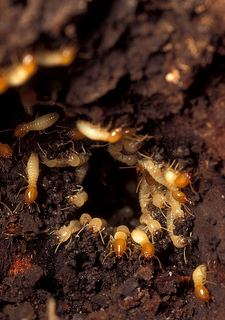Hey Massachusetts! – Here’s a Termite Checklist for Your Home
By Chris Williams on May 28, 2014.
 Subterranean termites require moist conditions to survive. To stay moist, they have to maintain a direct contact with the ground unless aboveground moisture or leaks provide them with a wet environment. Termites can move from the soil into your home by moving through underground foundation cracks, through wood members that are in the ground, or through protective mud tubes that they construct across open areas.
Subterranean termites require moist conditions to survive. To stay moist, they have to maintain a direct contact with the ground unless aboveground moisture or leaks provide them with a wet environment. Termites can move from the soil into your home by moving through underground foundation cracks, through wood members that are in the ground, or through protective mud tubes that they construct across open areas.
If your home has any of these features, you may be at higher risk for termite infestation:
- Cracks in concrete foundation. These give termites direct access to your house.
- Posts in concrete. If they go all the way through the concrete to the soil underneath, they invite termite attack.
- Short foundation walls. These may allow wooden members to contact the soil.
- Form boards. If left in place after construction is completed, they provide excellent termite food.
- Paper collars around pipes. Paper is made of wood pulp; termites will feed on it.
- Wooden forms around drains. Forms left in hole of slab where bathtub drain enters the home provide a direct route to inner walls.
- Brick veneer covering foundation. If bond fails, termites have hidden entrance between exterior and foundation.
- Earthfilled porches. Soil should be at least 6 inches below the level of any wooden members.
- Porch steps on ground. Steps in contact with soil literally offer termites a stairway into your home.
- Area around heating unit. Soil here is kept warm year round, accelerating termite development.
- Debris under and around house. Any wooden pieces help support a termite colony until the population is large enough to attack the house itself.
- Leaking pipes or faucets. They keep the wood or soil underneath moist continuously.
- Shrubbery by air vents. Anything that blocks air flow causes air underneath the house to remain warm and moist, an ideal climate for termites.
- Flower planters. If built against the house, they allow direct access to unprotected veneer, siding, or cracked stucco.
- Trellises. If a trellis touches the soil and is connected to the house, it provides a direct route for termites from soil to the wood in you home.
If any of these situations occur around your home, contact Colonial today for a termite inspection to determine your risk of infestation.
Photo credit: USDAgov / Foter / Creative Commons Attribution 2.0 Generic (CC BY 2.0)